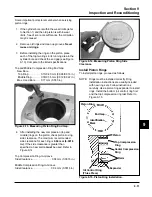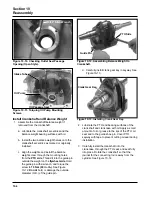
9.3
Section 9
Inspection and Reconditioning
9
Figure 9-2. Cylinder Bore Crosshatch after
Honing.
4. After honing, check the bore for roundness, taper,
and size. Use an inside micrometer, telescoping
gauge, or bore gauge to take measurements.
The measurements should be taken at three
locations in the cylinder at the top, middle, and
bottom. Two measurements should be taken
(perpendicular to each other) at each of the three
locations.
Clean Cylinder Bore after Honing
Proper cleaning of the cylinder walls following honing
is critical. Grit left in the cylinder bore can destroy an
engine in less than one hour of operation after a
rebuild.
The final cleaning operation should always be a
thorough scrubbing with a brush and hot, soapy water.
Use a strong detergent that is capable of breaking
down the machining oil while maintaining a good level
of suds. If the suds break down during cleaning,
discard the dirty water and start again with more hot
water and detergent. Following the scrubbing, rinse
the cylinder with very hot, clear water, dry it
completely, and apply a light coating of engine oil to
prevent rusting.
Measuring Piston-to-Bore Clearance
Before installing the piston into the cylinder bore, it is
necessary that the clearance be accurately checked.
This step is often overlooked, and if the clearances
are not within specifications, engine failure will usually
result.
NOTE: Do not use a feeler gauge to measure piston-
to-bore clearance it will yield inaccurate
measurements. Always use a micrometer.
Use the following procedure to accurately measure
the piston-to-bore clearance:
1. Use a micrometer and measure the diameter of
the piston perpendicular to the piston pin, up
8 mm (0.314 in.)
from the bottom of the piston
skirt as indicated in Figure 9-3.
3. When the bore is within
0.064 mm (0.0025 in.)
of
desired size, remove the coarse stones and
replace with burnishing stones. Continue with the
burnishing stones until within
0.013 mm
(0.0005 in.)
of desired size and then use finish
stones (220-280 grit) and polish to final size. A
crosshatch should be observed if honing is done
correctly. The crosshatch should intersect at
approximately 23-33° off the horizontal. Too flat
an angle could cause the rings to skip and wear
excessively, too steep an angle will result in high
oil consumption (refer to Figure 9-2).
Figure 9-3. Measuring Piston Diameter.
2. Use an inside micrometer, telescoping gauge, or
bore gauge and measure the cylinder bore. Take
the measurement approximately
63.5 mm
(2.5 in.)
below the top of the bore and
perpendicular to the piston pin.
3. Piston-to-bore clearance is the piston diameter
subtracted from the bore diameter (step 2 minus
step 1).
Balance Weight Assembly
The balance weight assembly counterbalances the
crankshaft weights and internal forces during operation
to minimize vibration. Several key areas of the balance
weight must be checked before installation and use.
Additionally, the mating components (crankshaft
eccentrics and closure plate guide channel) must also
be inspected for wear or damage.
Use the following procedure to check the balance
weight and matching components.
Measure 8 mm (0.314 in.) Above the Bottom of
Piston Skirt at Right Angles to Piston Pin.
8 mm (0.314 in.)
Содержание Kohler SV470
Страница 1: ...Workshop manual Kohler Courage Tractor Engines English ...
Страница 3: ......
Страница 17: ...1 14 Section 1 Safety and General Information ...
Страница 43: ...5 16 Section 5 Fuel System and Governor ...
Страница 93: ...9 14 Section 9 Inspection and Reconditioning ...
Страница 116: ...2004W27 114 03 04 26 ...
















































